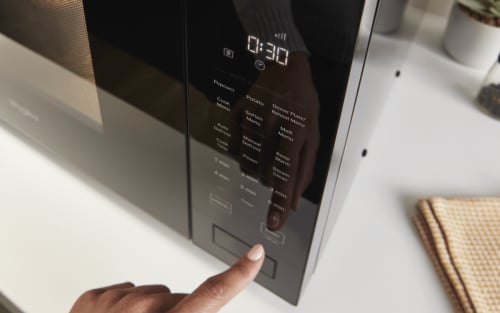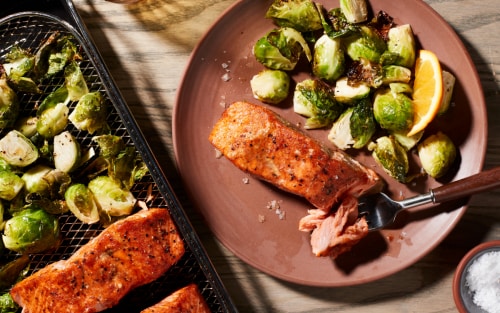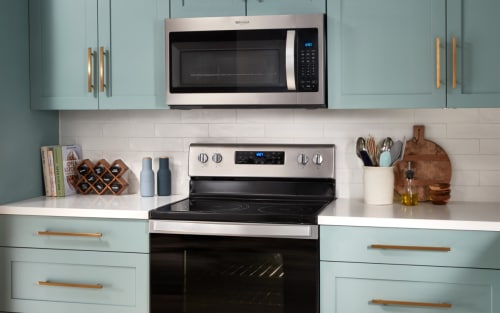
Deglazing a pan: what it means and how to do it
Deglazing salvages drippings and food bits from a pan while stovetop cooking and transforms them into an irresistible sauce. Discover five steps to deglazing a pan below, and find out which types of pans and deglazing liquids may work best for the process.
What is deglazing?
Deglazing is a simple cooking technique that involves adding a liquid like wine, stock or juice to a hot pan to help remove stuck-on food bits. You’ll typically do this once you’ve finished caramelizing or searing meats, vegetables or other aromatic ingredients in order to capture flavors and browned pieces left behind.
You can use this mixture of liquid and flavorful bits, called fond, to create sauces that can add complexity and richness to your dish.
What is the purpose of deglazing a pan?
This technique helps to release food particles from the bottom of a pan where you’ve just sauteed meats, vegetables or other ingredients. The mixture is then used to create a flavorful pan sauce. You may also use a method similar to deglazing to remove burnt cooking residue from pots and pans in the clean-up process.
What should you use to deglaze a pan?
Deglazing is all about extracting flavor, so your choice of liquid matters. Wine is well-suited to deglazing pans used for searing red meats, while stock best complements many soups and stews. You can also experiment with citrus juices or vinegar for a tangy twist or use water if needed—though it typically adds less flavor.
How to deglaze a pan
Learning how to properly deglaze a pan can help intensify the flavors of your dish. Follow the five steps below to discover which type of pan to use, how to choose a deglazing liquid and when to start the process.
Supplies
- Deglazing liquid (wine, beer, stock, juice, etc.)
Tools
Stainless steel, aluminum or cast-iron pan
Wooden spoon or spatula
Step 1: Prepare your stovetop dish
Whether you’re searing a sirloin steak or sauteing caramelized onions, begin by preparing the food you want to deglaze. As you sear, simmer or saute, try to prevent food bits from burning on the bottom of the pan—rather than simply sticking—as burnt food particles can make a sauce taste bitter. Turn the heat down or pull the pan off the burner if it starts to look too dark.
Step 2: Remove food and add liquid
Remove food from the pan and, while the pan is still hot, carefully add the deglazing liquid of your choice to the pan. Keep in mind that adding liquid to a hot pan can create a lot of steam.
Step 3: Scrape stuck-on food bits
Once your deglazing liquid hits the surface of the pan, work quickly, vigorously scraping, to loosen bits of food from the bottom of the pan using a wooden spoon or spatula.


Step 4: Boil mixture and reduce to simmer
With food particles loose, bring the mixture to a boil, then reduce it to a simmer. This helps to create a more potent flavor. Let the mixture simmer until it reaches your desired consistency. If you used alcohol, be sure it’s fully evaporated before removing the pan from the heat.
Step 5: Use mixture in sauce or as a glaze
Serve the deglazed mixture as a sauce or drizzle to accompany a complementary dish, or continue building upon it with more add-ins like spices or thickening agents prior to serving. For instance, a pan used to sear a sirloin steak can be deglazed and used to create a rich and creamy mushroom sauce.
Can you deglaze a nonstick pan?
You can opt for using a nonstick pan to cook and deglaze, but it’s not recommended. Deglazing works with food that sticks to the pan and then gets caramelized. Hence, a non-stick pan doesn’t really do the job as well. The process may not yield the same depth of flavor that’s produced by a cast iron or stainless steel surface, as a nonstick pan will hang on to fewer caramelized food bits and ultimately produce a less flavorful sauce.
Explore Whirlpool® Ranges and Cooktops
Whirlpool® Cooktops and Ranges give you more control over stovetop temperatures and settings so you can boil, simmer and saute your food until it’s exactly the way your family likes it. Select models feature the AccuSimmer® Burner which reduces power for better control at lower temperatures so you can melt chocolate and simmer sauces perfectly. Or, choose a model equipped with the SpeedHeat™ Burner, which generates high heat so you can sear or boil quickly—a handy feature for cooking techniques like deglazing.
Get more cooking tips from Whirlpool brand
-
 How to Cook or Steam Rice in the Microwave Learn how to make delicious rice in the microwave with this step-by-step guide. Get tips on how long to cook, how much rice to use and more.
How to Cook or Steam Rice in the Microwave Learn how to make delicious rice in the microwave with this step-by-step guide. Get tips on how long to cook, how much rice to use and more. -
 How to Air Fry Salmon: Quick and Easy Recipe Get the perfect air fried salmon with this easy, step-by-step recipe. Learn how to air fry salmon for a consistently delicious and savory meal.
How to Air Fry Salmon: Quick and Easy Recipe Get the perfect air fried salmon with this easy, step-by-step recipe. Learn how to air fry salmon for a consistently delicious and savory meal. -
 How to Make Microwave Steamed Carrots in 4 Steps Discover a simple method for making tender and flavorful microwave-steamed carrots. Our step-by-step recipe will help you create this delicious side dish in no time.
How to Make Microwave Steamed Carrots in 4 Steps Discover a simple method for making tender and flavorful microwave-steamed carrots. Our step-by-step recipe will help you create this delicious side dish in no time.


home heartbeat
Ready for more tips, home hacks and appliance guides?







